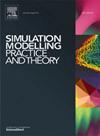Impact of communication performance measures for the Internet of Vehicles in an intersection scenario
IF 3.5
2区 计算机科学
Q2 COMPUTER SCIENCE, INTERDISCIPLINARY APPLICATIONS
引用次数: 0
Abstract
With the development of the Internet of Vehicles (IoV) technology and the advancement of autonomous driving technology, the efficiency of traffic flow has improved and the safety of driving and the convenience of travel have becoming better and better. However, in real-world intersection scenarios, there are still circumstances where the delay between vehicles is increased and the communication distance is largely decreased. Many scholars worldwide have analyzed and discussed the performance of LTE Mode 4 and the development of autonomous driving, such as the application and design of the LTE Mode 4. Therefore, this paper constructs a virtual IoV communication environment and conducts research on intersection control methods under the influence of communication performance. This paper provides reference values for the stability of vehicle communication network in actual road traffic pattern and provides a theoretical basis and data support for subsequent research on autonomous and adaptive sensor-based intersections.
交叉口场景下车联网通信性能指标的影响
随着车联网(IoV)技术的发展和自动驾驶技术的进步,交通流的效率得到了提高,驾驶的安全性和出行的便利性越来越好。然而,在真实的交叉口场景中,仍然存在车辆之间延迟增加,通信距离大大缩短的情况。国际上许多学者对LTE Mode 4的性能和自动驾驶的发展进行了分析和讨论,例如LTE Mode 4的应用和设计。为此,本文构建虚拟车联网通信环境,研究通信性能影响下的交叉口控制方法。本文为实际道路交通模式下车辆通信网络的稳定性提供了参考价值,为后续自主自适应传感器交叉口的研究提供了理论基础和数据支持。
本文章由计算机程序翻译,如有差异,请以英文原文为准。
求助全文
约1分钟内获得全文
求助全文
来源期刊

Simulation Modelling Practice and Theory
工程技术-计算机:跨学科应用
CiteScore
9.80
自引率
4.80%
发文量
142
审稿时长
21 days
期刊介绍:
The journal Simulation Modelling Practice and Theory provides a forum for original, high-quality papers dealing with any aspect of systems simulation and modelling.
The journal aims at being a reference and a powerful tool to all those professionally active and/or interested in the methods and applications of simulation. Submitted papers will be peer reviewed and must significantly contribute to modelling and simulation in general or use modelling and simulation in application areas.
Paper submission is solicited on:
• theoretical aspects of modelling and simulation including formal modelling, model-checking, random number generators, sensitivity analysis, variance reduction techniques, experimental design, meta-modelling, methods and algorithms for validation and verification, selection and comparison procedures etc.;
• methodology and application of modelling and simulation in any area, including computer systems, networks, real-time and embedded systems, mobile and intelligent agents, manufacturing and transportation systems, management, engineering, biomedical engineering, economics, ecology and environment, education, transaction handling, etc.;
• simulation languages and environments including those, specific to distributed computing, grid computing, high performance computers or computer networks, etc.;
• distributed and real-time simulation, simulation interoperability;
• tools for high performance computing simulation, including dedicated architectures and parallel computing.
 求助内容:
求助内容: 应助结果提醒方式:
应助结果提醒方式:


